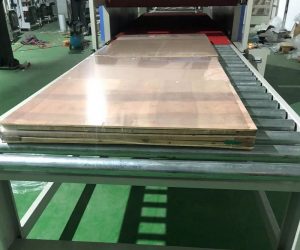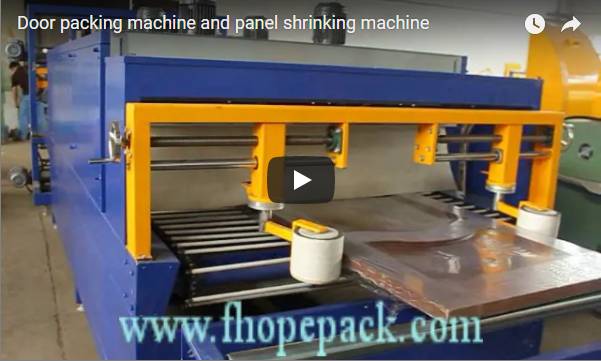Door and Panel Shrink Packaging Machine: Technology and Process
Shrink packaging provides a robust solution for protecting large, flat items like doors and panels during storage and transit. Specialized machinery, such as the door and panel shrink packaging machine demonstrated here, automates this process, ensuring consistency and efficiency. This type of machine typically employs a side-sealing mechanism followed by a heat shrink tunnel to fully encapsulate the product.

1. Core Operational Process
The automated packaging sequence generally follows these steps:
- Infeed: The door or panel is placed onto the infeed conveyor, which transports it towards the sealing station.
- Film Dispensing: Rolls of shrink film (often polyethylene - PE) are positioned above and below the conveyor path. As the product moves forward, it draws the film around it.
- Side Sealing & Edge Wrapping: The machine utilizes a side sealing bar (often heated) to create a continuous seal along one edge of the film. Simultaneously or subsequently, specialized rollers may press and seal the film along the leading and trailing edges of the packaged product.
- Film Cutting & Transfer: Once the product is enveloped, the film is typically cut to separate the packaged item from the continuous film supply.
- Shrink Tunnel Passage: The loosely wrapped product moves through a heat shrink tunnel. Controlled hot air circulation causes the film to shrink tightly around the contours of the door or panel.
- Cooling & Outfeed: After exiting the tunnel, the package may pass through a cooling zone to help the film set quickly, ensuring a tight, durable wrap before moving to the outfeed conveyor.
2. Key Components and Their Function
Understanding the main parts of the machine clarifies its operation:
- Infeed/Outfeed Conveyors: Transport the product through the system. Conveyor type (e.g., roller, belt) depends on product weight and handling requirements.
- Film Delivery System: Holds and dispenses the top and bottom rolls of shrink film, often with adjustable tension control.
- Side Sealing Unit: Creates the longitudinal seal. This can be a continuously heated bar or an intermittent sealing jaw, depending on the design. The rollers mentioned contribute to sealing the traverse edges in some configurations.
- Cross Seal / Cutting Unit: Seals and cuts the film between packages (may be integrated with the side seal or a separate station). Fhope system design the bagging covering by sealer.
- Shrink Tunnel: An insulated chamber with heating elements and blowers designed to circulate hot air uniformly around the package. Key parameters include temperature control and airflow adjustment.
- Control Panel: Typically features a PLC (Programmable Logic Controller) interface for setting and adjusting operational parameters like conveyor speed, sealing times/temperatures, and tunnel temperature.
3. Analyzing the Packaging Outcome (Video Reference)
The video showcases the machine processing a door. The resulting package exhibits key characteristics:
- Smooth Top and Bottom Surfaces: Achieved through proper film tension during wrapping and uniform heat application within the shrink tunnel, allowing the film to shrink evenly.
- Sealed Edges with Potential Wrinkles: The side seal provides closure along the length. The wrinkles observed on the traverse sides (where the rollers work) are characteristic of how the film gathers and seals in this type of side-seal operation. While ensuring a secure seal, complete elimination of wrinkles on these edges can be challenging and often depends on film type, thickness, and machine settings. The primary goal is protection and load stability.
4. Typical Technical Specifications (Example Range)
Specifications vary significantly based on the specific model and customization, but typical parameters might include:
- Max. Package Size (L x W x H): e.g., 2500mm x 1300mm x 100mm
- Sealing Width: e.g., Up to 1500mm
- Tunnel Dimensions (L x W x H - Opening): e.g., 2000mm x 1600mm x 200mm
- Conveyor Speed: e.g., 5-20 meters/minute (variable)
- Power Requirements: e.g., 380V, 50Hz, 3-Phase (region-dependent)
- Installed Power: e.g., 25-50 kW (tunnel heaters are significant consumers)
- Applicable Film: PE (Polyethylene) is common for doors/panels
- Film Thickness: e.g., 50-100 microns
Note: These are illustrative figures. Always refer to manufacturer specifications for accurate data.
5. Material Considerations: Shrink Film
Selecting the right shrink film is crucial. For doors and panels, Low-Density Polyethylene (LDPE) or Linear Low-Density Polyethylene (LLDPE) films are commonly used due to their:
- Durability and Puncture Resistance: Essential for protecting heavy, potentially sharp-edged items.
- Cost-Effectiveness: Generally lower cost compared to polyolefin films.
- Shrink Properties: Provides good tension to secure the product.
- Gauge (Thickness): Typically ranges from 60 to 100 microns (approx. 2.4 to 4 mil) for adequate protection.
6. Integration and Customization Potential
These machines are often designed for industrial environments and can be:
- Integrated into Production Lines: Placed downstream from manufacturing or finishing processes.
- Customized for Size: Built to accommodate specific maximum and minimum door/panel dimensions.
- Adapted for Handling: May include options like powered roller conveyors, belt conveyors, or specific guides depending on the product surface and weight.
- Enhanced with Safety Features: Light curtains, E-stops, and guarding are standard requirements.
7. Operational Best Practices
- Consistent Product Loading: Ensure panels are placed squarely on the infeed conveyor for proper film wrapping and sealing.
- Regular Cleaning: Keep sealing bars, rollers, and the shrink tunnel free of film residue and debris.
- Parameter Optimization: Fine-tune tunnel temperature and conveyor speed based on the film type/thickness and product size to achieve optimal shrink without overheating.
- Film Roll Alignment: Ensure top and bottom film rolls are correctly aligned for proper tracking and sealing.
- Routine Maintenance: Follow the manufacturer's schedule for lubrication, inspection of wear parts (sealing blades, heater elements, belts), and electrical checks.
Conclusion
Door and panel shrink packaging machines provide an automated, efficient method for applying protective shrink film to large, flat products. By understanding the operational sequence, key components, material interactions, and best practices, users can effectively leverage this technology to enhance product protection, improve handling efficiency, and ensure products arrive at their destination in optimal condition. The process balances throughput requirements with the need for a secure, conforming wrap tailored to the unique challenges of packaging items like doors and panels.
For more details on specific machine capabilities:
https://www.fhopepack.com/Door_packing_machine.html


